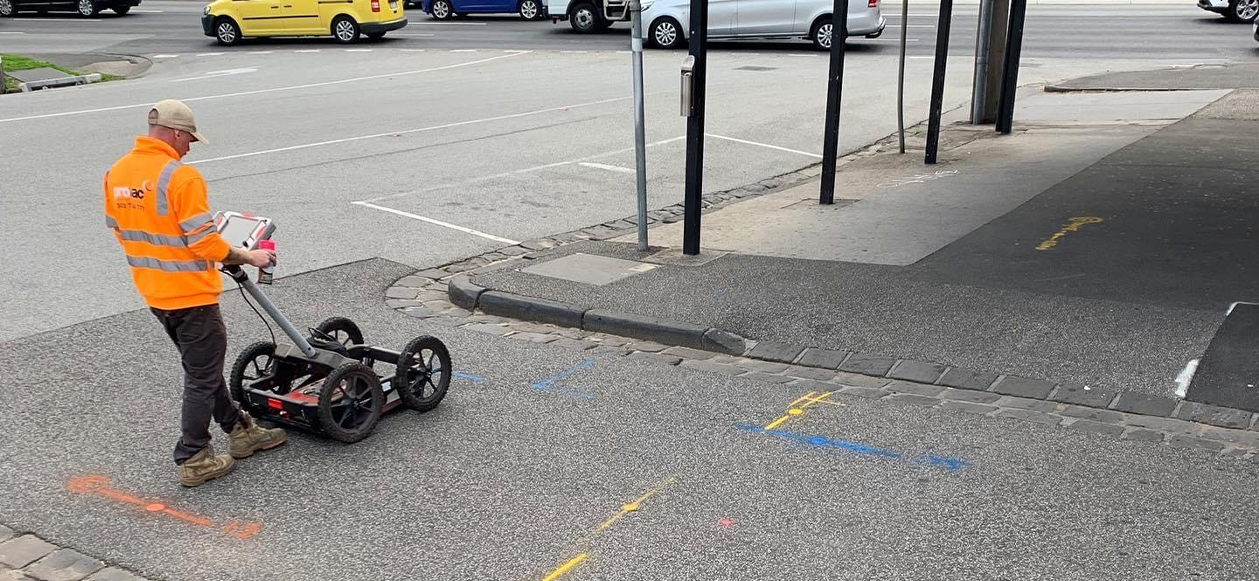Ground Penetrating Radar
GPR services in Melbourne and wider Victoria give you the full picture
Ground Penetrating Radar (GPR) is quite simply the geophysical technique of sub-surface imaging and surveying.
If you require GPR scanning services to be performed anywhere in Melbourne or greater Victoria before you begin any excavation work, Provac are at the helm to provide you with timely and accurate reports.
GPR gives you a deeper understanding
When you have construction plans, it’s important to get a thorough understanding of what is going on beneath the surface. You have a duty of care to ensure that any excavation work or activities undertaken do not affect the underground networks or utility services.
How does GPR work?
Ground Penetrating Radar is a sophisticated and non-destructive method of sending tiny impulses into the ground and recording their strength and the time taken for the signal to return. GPR technology has a high penetration depth, and can locate both metallic and non-metallic underground utilities.
When you might use GPR contractors in Melbourne or greater Victoria
GPR systems are a great way to locate buried underground assets such as water pipes. Water pipes can pose a significant issue if damaged. The water pressure in a water pipe is high, so imagine if you were to commence excavation work without knowledge of a water pipe below.
If the water pipe was compromised and broken, it could result in water escaping in a high-pressure situation, taking with it dirt and surrounding debris. Not only would this pose a significant threat to the workers and those in the vicinity, it can also create a whole host of other issues.
A burst water pipe can release pressure that might disturb other underground utilities, and thus a costly repair bill will be coming your way.
GPR can also assist with the location of power cables
Ground penetrating radar technology can also identify underground power cables. Power outages can cause much inconvenience to those affected, so it is important to identify the location of any underground power cables before undertaking any excavation or digging work.
GPR gives you the bigger picture
For a non-destructive, accurate and efficient way to get a deeper picture of the underground environment and what subsurface objects are present, we recommend that you call Provac for our ground penetrating radar services. Our team of underground service locating technicians cover all areas throughout Melbourne and greater Victoria with our state-of-the-art location technology.
All our technicians are Before You Dig certified, so you are in good hands. To get in touch with the Provac team, be sure to contact us.
Frequently Asked Questions
How much does a GPR scan cost?
The cost of a Ground Penetrating Radar (GPR) scan can vary depending on several factors, including the size of the area being scanned, the complexity of the site, and the depth of penetration required. At Provac Australia (VIC) Pty Ltd, we offer competitive pricing tailored to your specific project needs. Whether you require a small-scale utility scan or a comprehensive subsurface investigation, our team provides accurate and cost-effective solutions. To receive a detailed quote, contact Provac Australia (VIC) Pty Ltd, and our experts will assess your requirements to provide you with the best pricing options.
Can you locate optic fibre cables?
Yes. Although Optic Fibre cables are not traceable using electromagnetic methods, we have other tried and trusted methods for locating optic fibre cables. The most common way to locate optic fibre cables is by using a traceable copper reel which we can push up the pipe/conduit that the optic fibre is lay in. The copper reel is then traced using the electronic detection equipment and is accurately located like any other underground service.
Can GPR work under any surface?
The moisture level on the surface being scanned greatly impacts the accuracy of the scan. Excessive moisture enhances conductivity, causing the equipment's signal to bounce back and resulting in subpar readings.
Performing a concrete scan becomes particularly challenging on newly poured concrete that is less than three months old due to its higher moisture content. Other surfaces that pose difficulties for scanning include those with heavy insulation, as well as marble and granite.
How do electronic locations work?
There are a number of different methods we use to locate underground services. The best and most common way to locate an underground asset is by using electromagnetic methods. This is done by using a transmitter and receiver. The transmitter is used to emit a signal through the pipe and cable which is then picked up using the receiver. Other methods we utilise include GPR (Ground penetrating radars) primarily used to locate non conductive pipes such as PVC water mains and poly pressure sewer rising mains. At Provac Australia we use the most advanced, state of the art electronic detection equipment. We accurately locate, mark and utility map all electronic locations on every job.
How accurate are electronic locations?
Electronic Locations are extremely accurate in most cases but are still only classified as ‘Class B’ locations in the Classification of Subsurface Utility ‘AS 5488’ guidelines. Electronic Locations must be safely potholed via hand excavation or with a Vac truck so that a visible confirmation of the underground asset can attain a ‘Class A’ location in accordance with the Classification of Subsurface Utility ‘AS 5488’ guidelines.
How is GPR used in concrete scanning?
Ground Penetrating Radar (GPR) is an effective method for scanning concrete to detect and map the presence of hidden features, such as rebar, post-tension cables, pipes, and voids. By sending high-frequency radio waves into the concrete, GPR captures the signals reflected back from objects or changes in material, providing detailed images of the internal structure.
In concrete scanning, GPR is typically used for non-invasive inspection, helping to identify potential issues before any drilling or cutting begins. Provac Australia (VIC) Pty Ltd utilises GPR ground technology to deliver precise concrete scanning services, ensuring safety and efficiency on construction sites. With Provac’s advanced ground penetrating radar systems, clients can avoid costly damage to underlying structures and improve the accuracy of their work. Our ground penetrating survey methods are ideal for assessing the condition of concrete structures with minimal disruption.
Can you locate my house connections?
Yes. We often locate all underground service house connections for our clients. This is often required by home owners and property developers when looking to demolish or renovate external structures.
Is GPR useful for detecting water leaks?
Yes, Provac Australia (VIC) Pty Ltd provides advanced ground penetrating radar (GPR) technology that is highly effective for detecting water leaks. GPR technology works by transmitting electromagnetic waves into the ground and analysing the reflected signals, allowing technicians to identify subsurface changes that may indicate the presence of water or moisture. With specialised ground penetrating survey equipment, Provac Australia (VIC) Pty Ltd can accurately detect anomalies in underground infrastructure, including water pipes. This technology helps pinpoint the exact location of leaks, reducing the need for invasive digging and minimising repair costs. By utilising ground penetrating radar, Provac Australia (VIC) Pty Ltd ensures efficient and accurate leak detection solutions for both residential and commercial properties.
What can Ground Penetrating Radar show?
Ground Penetrating Radar (GPR) is a non-invasive technology that detects buried utilities like gas, electrical, water, and telecom lines, as well as other subsurface features, using radar waves. GPR emits electromagnetic energy into the ground, which bounces back and is detected, providing information on the depth and composition of subsurface features. It helps reduce damage risk in construction and engineering projects by locating underground utilities before excavation.
Is it safe to use a Ground Penetration Radar?
Yes, Ground Penetrating Radar (GPR) is generally safe to use. It emits low-power electromagnetic waves and doesn't involve ionising radiation like X-rays. However, users should be cautious of electromagnetic interference, follow guidelines on safe distances, consider environmental impacts, and adhere to any local regulations. Proper training and awareness of potential risks are important for a safe GPR operation.
How accurate is Ground Penetrating Radar (GPR)?
Ground-penetrating radar (GPR) is an effective and efficient technology used to survey subsurface features and structures. Its accuracy is largely dependent on the quality of equipment, operator skill, and subsurface conditions. GPR offers high-resolution imaging with a depth resolution that can range from centimetres to meters, providing valuable insights into the subsurface. Despite some limitations, such as interference from metal objects or other sources, GPR is a reliable and valuable tool for subsurface imaging and often provides accurate results.
How deep can electronic locators detect a pipe or cable?
Our state of the art Radio Detection equipment has been capable of accurately locating underground services up to 10m deep below the earth’s surface.
Do I need electronic locations before I begin excavations?
Yes. It is your legal obligation to use a Before You Dig Australia accredited Locator to locate all underground services before you commence any excavations. If you excavate without first consulting a DBYD accredited locator and an asset is damaged, you will be held liable for the damages and all costs associated with that damage.
Can Ground Penetrating Radar identify underground utilities?
Yes, Ground Penetrating Radar (GPR) can identify underground utilities like pipes, cables, and conduits by analysing radar reflections. It's widely used in construction to prevent accidental damage during excavation and to map utility locations.
Can a Ground Penetration Radar be used in water, snow, or ice?
Yes, Ground Penetrating Radar (GPR) can be used in water, snow, and ice. It helps measure sediment layers underwater, snowpack properties, and ice thickness. However, effectiveness varies due to factors like conductivity and equipment adjustments needed for each medium.
What types of projects benefit most from non-destructive digging?
Non-destructive digging (NDD) is invaluable for projects requiring precision and minimal disruption, such as utility installation and maintenance, roadworks, and infrastructure upgrades. It is ideal for landscaping, site preparation, and environmental assessments, where preserving existing structures and minimising impact are crucial. NDD is also essential for repairing or replacing underground utilities, building and construction projects, and emergency response scenarios, offering a safe and efficient way to manage subsurface work while protecting existing infrastructure and the environment.
How do I know if non-destructive digging is the right choice for my project?
Consulting with Provac’s experts can help determine if NDD is suitable for your project. They will assess the site conditions, project requirements, and potential risks to recommend the most appropriate method.
How does non-destructive digging compare to traditional excavation methods?
Non-destructive digging (NDD) offers several advantages over traditional excavation methods, primarily in terms of precision, safety, and environmental impact. Unlike traditional excavation, which often involves digging with heavy machinery that can damage underground utilities and structures, NDD uses techniques such as vacuum excavation or hydro excavation to safely and accurately remove soil without causing disruption. This method significantly reduces the risk of damaging existing utilities, enhances worker safety, minimises surface disruption, and is more environmentally friendly. Additionally, NDD can lead to cost savings by preventing costly repairs and project delays associated with utility damage, making it a more efficient and reliable choice for sensitive or complex excavation tasks.
Victoria Division
- Monday - Sunday: 24 Hours

